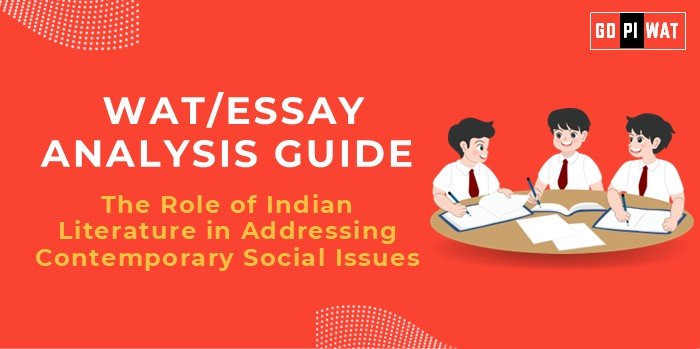📚 Written Ability Test (WAT)/Essay Analysis Guide
📜 Topic: The Role of Indian Literature in Addressing Contemporary Social Issues
🌟 Understanding the Topic’s Importance
Literature’s capacity to evoke empathy and inspire societal change aligns with B-school themes of leadership, diversity, and innovation.
⏳ Effective Planning and Writing
- Time Allocation: 5 mins planning, 20 mins writing, 5 mins reviewing.
- Preparation Tips: Focus on identifying 2-3 key examples, such as works addressing caste or gender issues.
✍️ Introduction Techniques for Essays
- Contrast Approach: “While technology shapes our future, literature preserves our essence, tackling issues technology cannot address.”
- Historical Approach: “From the verses of Kabir to the prose of Arundhati Roy, Indian literature has been a relentless crusader against societal injustice.”
📖 Structuring the Essay Body
- Achievements: Highlight success stories, like the influence of “Untouchable” by Mulk Raj Anand on caste discussions.
- Challenges with Comparative Analysis: Discuss censorship in India vs. the freedom of expression in Scandinavian countries.
- Future Outlook: Literature’s role in shaping an inclusive, informed society amid rising digitization.
🤔 Concluding Effectively
- Balanced Perspective: “Indian literature has significantly addressed social issues but must evolve to bridge accessibility gaps.”
- Global Comparison: “Just as African literature has spotlighted apartheid, Indian literature can globalize the discourse on caste and gender.”
🔍 Analyzing Successes and Shortcomings
- Achievements: Catalyzed grassroots movements, won global acclaim.
- Challenges: Limited readership, political censorship.
- Global Context: Draw parallels with social movements abroad fueled by literature.
🔧 Recommendations for Sustainable Progress
- Promote translations to cross linguistic barriers.
- Foster collaborations between authors and digital platforms to increase reach.
- Encourage schools to integrate contemporary literature into their curricula.
📄 Sample Short Essays
1. Balanced Perspective
“Indian literature, through its diverse narratives, addresses social inequalities. Yet, its true potential remains untapped due to barriers in accessibility and representation.”
2. Solution-Oriented
“By embracing technology and fostering inclusivity, Indian literature can transcend boundaries, inspiring meaningful societal change.”
3. Global Comparison
“Indian literature, much like African-American literature during the Civil Rights Movement, has the power to globalize and address deeply rooted social inequities.”


